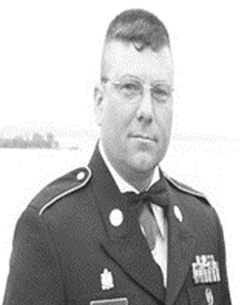SGM Tim A. Ozman
 SGM Tim A. Ozman was born on July 6th 1963 in Easton, Maryland. He entered active duty on 17 March 1982 and attended Basic Training and Advanced Individual Training at Fort Jackson, South Carolina, with the Military Occupation-al Specialty of 63S, Heavy Wheeled Vehicle Mechanic. During his initial entry training, then PVT Ozman was recognized as the Soldier of the Cycle (Basic) and Distinguished Graduate (AIT), establishing early on a pattern of superior performance.
SGM Tim A. Ozman was born on July 6th 1963 in Easton, Maryland. He entered active duty on 17 March 1982 and attended Basic Training and Advanced Individual Training at Fort Jackson, South Carolina, with the Military Occupation-al Specialty of 63S, Heavy Wheeled Vehicle Mechanic. During his initial entry training, then PVT Ozman was recognized as the Soldier of the Cycle (Basic) and Distinguished Graduate (AIT), establishing early on a pattern of superior performance.
On 1 May, 1992 newly promoted SFC Ozman was selected by the 7th CSG Commander (COL, later LTG Charles Mahan) to fill the Senior Maintenance Supervisor position in the group S4. Filling a designated E8 position proved to be no issue for Ozman, who spear-headed several initiatives that enabled the 43 company sized units in 7 CSG to recover from Operation Desert Storm. These initiatives included the creation of a consolidated database of all 43 PLLs so that units could collaborate for needed NMC parts; overseeing the enrollment of both HET companies M911 fleets into refurbishment programs, as well as the 181 Trans battalions M871 fleet; scheduling and oversight of the CARC paint program designed to fight the corrosive environmental effects of prolonged deployments; and frequent courtesy assistance visits to each company sized element to establish sound command relationships. The result was a reduction in NMC over 30 from 279 to under 30, the best improvement in V Corps.
Later, SFC Ozman was handpicked to serve in the largest FMS case in the Army to serve as the Transportation Branch Chief in OPM-SANG, part of the US Army Security Assistance Command (USASAC). In this position, he was responsible for the organization-al through general support maintenance of 321 vehicles, supervising 61 multinational personnel from 10 different countries, none of whom spoke English as a first language. He was also responsible for the daily transport of 100 local hire personnel to and from work over 26 different routes throughout the greater Riyadh area. His performance in this role is commendable: he achieved and maintained a 96% materiel readiness rate while processing an average of 267 work orders and 1,140 transportation requests. Through his training efforts, the rate of work orders closed within 24 hours rose by 97%, all while reducing repair parts stockage by 53% with no degradation of support.
After redeployment to Germany, SGM Ozman was selected to serve as the Chief Enlisted Career Manager for the Ordnance Corps. Arriving at Aberdeen Proving Ground in Aug 2007, Ozman found many challenges in his new assignment, most notably the transformation to the modular force, as well as the concurrent transition to two level maintenance, both initiatives which played havoc with force structure. In an effort to achieve and maintain healthy promotion pyramids that met the needs of the Army, Ozman led the PPO staff in the analysis, development, and submission of over 27 MOCS proposals—over twice as many as any other branch during this turbulent time period. Ozman did not initiate the proposal to award promotion points for professional certifications, but he followed through and got this initiative passed and implemented during his tenure. SGM Ozman was a key contributor in a TRADOC initiative to deliver MTT NCOES at home station for Soldiers recently returned from deployment with short dwell times, so they could receive critical training while going home to their families each night. Ordnance was one of only four branches that executed these PME courses. Also during this assignment, Ozman accomplished what is probably his biggest contribution to the Ordnance Corps—the conceptualization and development of Skills Based training (SBT), the first true update to Ordnance training strategy in 26 years. Its subsequent implementation has drawn rave reviews from TRADOC staff, who have encouraged other branches to implement the same concept.
SGM Ozman retired on 1 August 2007.